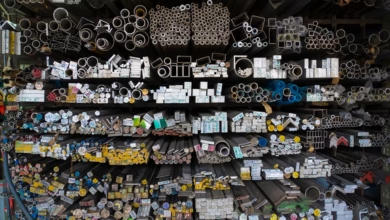Unlocking the Skies: The Essential Role of Aerospace Metals like Titanium and Emerging Trends in Sustainable Production

**Introduction**
In the ever-evolving landscape of aviation, the quest for lightweight yet durable materials has become paramount. Aerospace metals, particularly titanium and its unique alloys, are at the forefront of this revolution, offering unparalleled strength-to-weight ratios essential for modern aircraft design. As the aerospace industry strives for greater efficiency and sustainability, understanding the role of various metals—including precious, ferrous, and non-ferrous options—becomes crucial. This article will explore the significance of titanium and other lightweight alloys in contemporary aviation, delve into the future potential of rare earth metals and sustainable production methods, and highlight innovative trends in metal fabrication and 3D printing that enhance durability and performance. By examining these facets, we will uncover how advancements in metallurgy and metal recycling are shaping the future of aerospace applications, ensuring that both the environment and the industry thrive together. Join us on this journey through the fascinating world of aerospace metals, where the interplay of industrial metals and cutting-edge technology is paving the way for a new era in aviation.
- 1. "Exploring Aerospace Metals: The Role of Titanium and Other Lightweight Alloys in Modern Aviation"
- 2. "The Future of Aerospace Applications: From Rare Earth Metals to Sustainable Metal Production"
1. "Exploring Aerospace Metals: The Role of Titanium and Other Lightweight Alloys in Modern Aviation"
The aerospace industry has long relied on a variety of metals, but none have made quite the impact as titanium and its lightweight alloys. As aircraft design evolves toward greater efficiency and sustainability, the role of aerospace metals has become increasingly critical. Titanium, a non-ferrous metal known for its exceptional strength-to-weight ratio, is a prime candidate for modern aviation applications. Its low density allows for a reduction in overall aircraft weight, which directly translates to fuel savings and enhanced performance.
In addition to titanium, other industrial metals such as aluminum and magnesium play vital roles in aircraft manufacturing. Aluminum, a base metal, is commonly used due to its excellent corrosion resistance and lightweight characteristics. Coupled with advancements in metallurgy, these metals are often engineered into sophisticated metal alloys, which further enhance their properties for aerospace applications. For instance, aluminum-lithium alloys have become popular due to their reduced weight and improved mechanical performance, making them suitable for both structural components and fuel tanks.
Moreover, the growing trend towards sustainable metal production is reshaping how the aerospace sector approaches material sourcing and fabrication. Metal recycling initiatives are becoming more prevalent, allowing manufacturers to reuse valuable metals and reduce waste. This not only conserves resources but also minimizes the environmental impact associated with metal mining, particularly for precious and rare earth metals.
As the industry continues to embrace innovative technologies such as 3D printing metals, the landscape of aerospace manufacturing is rapidly changing. This method allows for the production of complex geometries that were previously impossible, further optimizing the use of lightweight metals while reducing material costs.
Finally, while metals like platinum and palladium are often associated with jewelry or energy sectors, their applications in aerospace can’t be overlooked. These refractory metals are utilized in high-temperature environments, such as turbine engines, where their resilience to metal corrosion is crucial. As we explore the future of aviation, it's clear that the integration of advanced lightweight alloys, including titanium, will remain a cornerstone in the development of efficient and sustainable aircraft designs.
In summary, the evolution of aerospace metals, driven by the demand for lighter, stronger, and more sustainable materials, underscores the importance of titanium and its alloys in modern aviation. As we look forward to the next generation of aircraft, the continued innovation in metallurgy and metal fabrication will undoubtedly play a pivotal role in shaping the skies of tomorrow.
Aerospace applications demand materials that are both lightweight and exceptionally durable, making aerospace metals a vital focus in the industry. Among these, titanium stands out not only for its strength-to-weight ratio but also for its corrosion resistance, making it an ideal choice for aircraft and spacecraft components. The use of non-ferrous metals, such as aluminum and titanium alloys, has become increasingly prevalent in the aerospace sector, as they offer significant advantages over traditional ferrous metals like steel.
In addition to titanium, other industrial metals play crucial roles in aerospace construction. Aluminum, for instance, is known for its lightweight characteristics and is widely used in airframe structures. The combination of aluminum with rare earth metals can further enhance its properties, allowing for increased performance in critical components. Similarly, advancements in metallurgy have led to the development of advanced metal alloys that meet the rigorous demands of aerospace applications while maintaining lower weights.
Metal recycling is becoming an integral part of sustainable metal production, particularly in the aerospace industry. By reprocessing and reusing metals, companies can reduce their environmental footprint and ensure a continuous supply of essential materials. The focus on sustainable practices aligns well with the growing trends in metal commodities, where investors are increasingly looking at gold investing and silver investing as alternatives to traditional investments.
Moreover, the rise of 3D printing metals has opened new avenues for aerospace manufacturing. This technique allows for the creation of complex geometries that were previously unachievable, thereby optimizing designs and reducing material waste. As the demand for advanced aerospace technologies grows, the integration of battery metals like lithium and energy metals into aerospace systems becomes more prevalent, supporting innovations in electric aircraft and sustainable aviation solutions.
Overall, the aerospace industry is at the forefront of metal trends, utilizing a range of metals and metal alloys to drive performance, sustainability, and innovation. As we continue to explore the potential of these materials, it is crucial to consider the implications of metal corrosion and the ongoing need for metal fabrication techniques that enhance the longevity and reliability of aerospace components.
2. "The Future of Aerospace Applications: From Rare Earth Metals to Sustainable Metal Production"
The aerospace industry is on the brink of a transformative evolution, driven by advancements in metallurgy and the increasing demand for sustainable practices. As we look to the future, the role of metals, particularly aerospace metals like titanium and aluminum, is becoming more critical. With the ongoing exploration of rare earth metals and their applications, we are witnessing a shift towards more sustainable metal production methods that can support both the aerospace sector and other industries.
One of the key trends is the focus on non-ferrous metals, which include lightweight and durable options such as titanium and aluminum. These metals not only enhance fuel efficiency but also reduce overall emissions in aerospace applications. As manufacturers explore ways to integrate metal alloys that feature a combination of base metals like copper and zinc, they are pushing the boundaries of metal fabrication techniques to produce components that are both strong and lightweight.
Sustainable metal production is gaining momentum as companies become more aware of the environmental impacts of traditional metal mining and processing. Implementing metal recycling initiatives is crucial for reducing waste and conserving resources. For instance, the recycling of precious metals like gold and platinum, as well as industrial metals such as steel and aluminum, can significantly minimize the energy consumption and environmental damage associated with new metal mining. This practice not only aligns with sustainability goals but also presents a lucrative opportunity for investors interested in gold investing and silver investing, as the value of recycled metals continues to rise.
As we move forward, the development of energy metals, including lithium and palladium, will also play a pivotal role in aerospace applications. These metals are essential for battery technologies and energy storage solutions, which are becoming increasingly important as the industry shifts towards electric and hybrid aircraft. Furthermore, advancements in 3D printing metals are revolutionizing the production of aerospace components, allowing for more complex designs and reducing material waste.
In conclusion, the future of aerospace applications hinges on the innovative use of both traditional and emerging metals. By embracing sustainable metal production and recycling practices, the aerospace industry can not only enhance performance but also contribute to a greener future. As we navigate this new era, the interplay between metallurgy, metal trends, and environmental responsibility will shape the landscape of aerospace technologies for years to come.
In conclusion, the landscape of aerospace metals is rapidly evolving, driven by the demand for lightweight and durable materials like titanium and other innovative alloys. As we explore the critical role of these industrial metals in modern aviation, it becomes clear that their properties not only enhance performance but also contribute to fuel efficiency and reduced emissions. The future of aerospace applications promises exciting developments in sustainable metal production and recycling, which will further minimize the environmental impact of metal mining and fabrication.
As industries pivot towards more sustainable practices, the integration of rare earth metals and advanced metallurgy will be essential in meeting the growing needs of aerospace, automotive, and energy sectors. The advancement of technologies such as 3D printing metals will revolutionize how we approach metal commodities, creating opportunities to optimize designs and reduce waste.
Investing in precious metals like gold and silver, along with base metals such as aluminum, copper, and zinc, remains a strategic move for those looking to capitalize on the shifting trends in the market. Additionally, as we continue to innovate in metal corrosion resistance and the utilization of refractory metals, the potential for enhanced performance in aerospace and beyond is limitless.
Ultimately, the ongoing exploration of aerospace metals and their applications will not only redefine modern aviation but also pave the way for a more sustainable future in various industries. Staying informed about these metal trends is crucial for stakeholders looking to adapt and thrive in this dynamic environment.
—
(Note: Ensure to replace the placeholders and adjust the tone as needed for your specific audience.)





